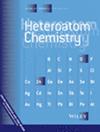Synthesis of new functionalized hydroxy- and aminomethylphosphinates with indan moieties
IF 1.4
4区 化学
Q3 CHEMISTRY, MULTIDISCIPLINARY
引用次数: 6
Abstract
The convenient synthesis of new functionalized organophosphorus acids and their derivatives containing indan moieties was developed. The regioselective radical addition of bis(trimethylsiloxy)phosphine to indene proceeds to give rise to 2-indanylphosphonite as key compound for preparation of above acids with bicyclic substituents. Azobis(isobutyronitrile) (AIBN) in the conditions of its thermolysis was used as effective initiator of the addition reaction. The further treatment of organophosphorus acids trimethylsilyl esters with the methanolic sodium methoxide solution resulted in the water-soluble sodium salts of the corresponding acids.
新型茚丹官能化羟基和氨基甲基膦酸酯的合成
研究了一种方便合成含吲哚基的新型官能化有机磷酸及其衍生物的方法。二(三甲基硅氧基)膦与吲哚的区域选择性自由基加成得到2-吲哚基膦酸盐,这是制备上述含双环取代基酸的关键化合物。以偶氮铋(异丁腈)(AIBN)在其热裂解条件下作为加成反应的有效引发剂。用甲醇甲醇钠溶液进一步处理有机磷酸三甲基硅酯,得到相应酸的水溶性钠盐。
本文章由计算机程序翻译,如有差异,请以英文原文为准。
求助全文
约1分钟内获得全文
求助全文
来源期刊

Heteroatom Chemistry
化学-化学综合
CiteScore
1.20
自引率
0.00%
发文量
5
审稿时长
6 months
期刊介绍:
Heteroatom Chemistry brings together a broad, interdisciplinary group of chemists who work with compounds containing main-group elements of groups 13 through 17 of the Periodic Table, and certain other related elements. The fundamental reactivity under investigation should, in all cases, be concentrated about the heteroatoms. It does not matter whether the compounds being studied are acyclic or cyclic; saturated or unsaturated; monomeric, polymeric or solid state in nature; inorganic, organic, or naturally occurring, so long as the heteroatom is playing an essential role. Computational, experimental, and combined studies are equally welcome.
Subject areas include (but are by no means limited to):
-Reactivity about heteroatoms for accessing new products or synthetic pathways
-Unusual valency main-group element compounds and their properties
-Highly strained (e.g. bridged) main-group element compounds and their properties
-Photochemical or thermal cleavage of heteroatom bonds and the resulting reactivity
-Uncommon and structurally interesting heteroatom-containing species (including those containing multiple bonds and catenation)
-Stereochemistry of compounds due to the presence of heteroatoms
-Neighboring group effects of heteroatoms on the properties of compounds
-Main-group element compounds as analogues of transition metal compounds
-Variations and new results from established and named reactions (including Wittig, Kabachnik–Fields, Pudovik, Arbuzov, Hirao, and Mitsunobu)
-Catalysis and green syntheses enabled by heteroatoms and their chemistry
-Applications of compounds where the heteroatom plays a critical role.
In addition to original research articles on heteroatom chemistry, the journal welcomes focused review articles that examine the state of the art, identify emerging trends, and suggest future directions for developing fields.
 求助内容:
求助内容: 应助结果提醒方式:
应助结果提醒方式:


